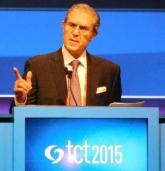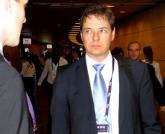News

TCT: Absorb BVS meets pivotal U.S. noninferiority goal
Key clinical point: The Absorb bioresorbable vascular scaffold met its prespecified noninferiority primary endpoint in its pivotal U.S.

AT TCT 2015
SAN FRANCISCO – Two-year clinical outcomes did not differ significantly between patients treated with the Absorb everolimus-eluting bioresorbable vascular scaffold (BVS) and those treated using the Xience everolimus-eluting stent.
In ABSORB II, the first randomized trial to compare the two devices, 11.6% of 335 Absorb BVS patients and 12.8% of 166 Xience patients experienced a patient-oriented composite endpoint that included all death, myocardial infarction, and revascularization, Dr. Bernard Chevalier reported on behalf of the ABSORB II investigators at the Transcatheter Cardiovascular Therapeutics annual meeting.
Furthermore, 7.6% and 4.3% of patients in the Absorb BVS and XIENCE groups, respectively, experienced a major adverse cardiac event, and 7.0% and 3.0%, respectively, experienced a device-oriented composite endpoint (DoCE), or target-lesion failure, including cardiac death, target-vessel MI, and clinically indicated target-lesion revascularization, he said at the meeting, sponsored by the Cardiovascular Research Foundation.
Target-vessel failure, defined as cardiac death, all MI, or clinically indicated target-vessel revascularization, occurred in 8.5% and 6.7% of patients in the groups, respectively, said Dr. Chevalier of Institut Jacques Cartier, Massy, France.
“There was no significant difference on any of these composite endpoints,” he said.
Similarly, no differences were seen with respect to nonhierarchical clinical outcomes at 2 years, he said.
Cardiac death occurred in 1.2% of the Absorb patients and 0.6% of the Xience patients, and noncardiac death occurred in 0.6% and 0% of patient in the groups, respectively; Q-wave MI occurred in 1.5% and 0.6%, and non–Q-wave MI occurred in 4.3% and 1.8%; and definite/probable scaffold thrombosis occurred in 1.54% and 0% of patients in the groups, respectively. The thrombosis events in the Absorb BVS patients included acute/subacute events (occurring at 0-30 days) in 0.60% of patients, late events (occurring at 31-365 days) in 0.30% of patients, and very-late events (at 365-758 days) in 0.62% of patients.
There were no significant differences between groups in postprocedure usage of antiplatelet medications, either for aspirin alone or dual-antiplatelet therapy.
While the findings suggest noninferiority of the Absorb BVS, it is important to keep in mind the limitations of ABSORB II, including the fact that the study was not powered for clinical endpoints, and the 2-year analysis represented a nonprespecified interim analysis, Dr. Chevalier said, noting that the primary endpoint is a 3-year measure of vasomotion.
Furthermore, the investigators’ long experience with Xience, as compared with Absorb BVS, might have affected the results, he noted.
Regarding the persistent numerically, though not statistically significant, worse outcomes for the Absorb BVS vs. the Xience stent on several measures in the ABSORB trials, Dr. Chevalier noted that it remains too early to draw conclusions about potential long-term outcomes. He, along with discussants Dr. Pascal Vranckx of Hartcentrum Hasselt, Belgium, and Dr. Marie-Claude Morice of Institut Hospitalier Jacques Cartier, Massy, stressed that the continued findings of noninferiority of the Absorb device are encouraging, and that at least 3- to 5-year outcomes are needed.
“What’s important, winning the battle or winning the war?” Dr. Vranckx said, stressing that the shorter-term data showing noninferiority don’t provide a clear picture of the end results, but do offer reassurance that the Absorb BVS could ultimately provide an improved alternative to permanent metal stents.
Dr. Daniel I. Simon of University Hospitals Case Medical Center, Cleveland, agreed that the focus should be on the device-related finding.
“The DoCE is what we need to focus on. If the DoCE over time doesn’t narrow down, then potentially there’s an issue. But I think right now we need more people at 24 months, and we have more than twice the number [of patients] in ABSORB III, so I think we have to stay tuned,” he said.
The results of ABSORB III, showing the Absorb scaffold’s noninferiority to the Xience stent at 1 year, were also presented at TCT, and published online (N Engl J Med. 2015 Oct 12;doi: 10.1056NEJMoa1509038).
Dr. Chevalier is a consultant for Abbott Vascular, which sponsored the ABSORB II trial.

Key clinical point: The Absorb bioresorbable vascular scaffold met its prespecified noninferiority primary endpoint in its pivotal U.S.

